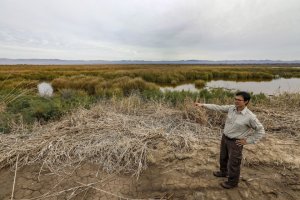It came as a bittersweet surprise to biologists and government agencies monitoring the steadily shrinking Salton Sea’s slide toward death by choking dust storms and salt.
Thousands of acres of exposed lake bed have become, of all things, the unintended beneficiaries of lush marshlands that are homes for endangered birds and fish at the outlets of agricultural and urban runoff that used to flow directly into the Salton Sea.
These unmanaged flows, scientists say, are flushing salinity out of the soil and forming freshwater ponds on the lake’s margins, which are attracting cattails and grasses. They, in turn, are attracting insects, which are enticing federally endangered desert pupfish and birds such as the Yuma Ridgway’s rail.
“Beautiful, isn’t it?” Tom Anderson, a biologist with the U.S. Fish and Wildlife Service, said on a recent weekday, admiring a swath of cattails at the southern end of the lake filled with the chattering sounds of endangered rails creeping through the dense vegetation. “Not exactly the gloom-and-doom apocalypse some people have been predicting for this place, is it?”
Read the full story on LATimes.com.

Amid the wasteland of the Salton Sea, a miraculous but challenging oasis is born https://t.co/sKv7L7H9ll
— Louis Sahagun (@LouisSahagun) December 9, 2019






